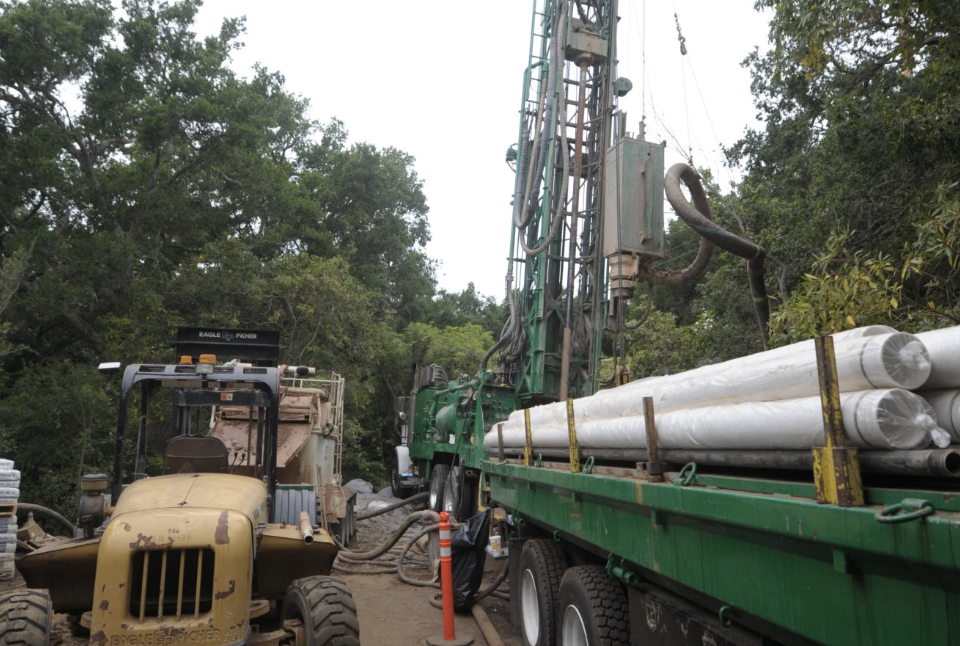The groundwater basins on most of the urban South Coast are drought buffers of last resort, to be conserved for pumping in emergencies.
But in Montecito, as many as 1,500 private well owners may have “straws” in the same small basin as the Montecito Water District with its 12 public wells, a team of consultants told the district board this month.
The private wells, together with the shallow configuration of the basin, will make it hard for the district to treat wastewater to drinking water standards and inject it into the ground, Tim Thompson, a hydrogeologist with GSI Water Solutions, a Santa Barbara company, told the board.
“It’s not the story I was hoping to tell here,” he said.
The seven-year drought has ended, but it has left the Montecito Water District thirsting for supplies that don’t rely on rain and reservoirs. Among other initiatives, the district board is poised to raise rates to purchase a $4 million yearly supply of Santa Barbara water for the next 50 years. The district serves 11,000 residents; the city would produce the extra supply at its desalination plant.
In pursuing recycled wastewater, the board commissioned the $125,000 GSI study of Montecito’s groundwater basin, brushing aside a 2015 geological report that found the basin had “limited recharge potential.” A state grant is expected to help defray half the cost of the GSI report, district officials said. It will be released later this year.
Floyd Wicks, the water board president, has promoted the injection of highly treated wastewater into the ground — called “indirect potable reuse” — as a way of employing a recycled supply year-round, including during the wet months. The cost of such a project has been estimated at $31 million.
But the district’s hopes for indirect potable reuse in Montecito seemed to evaporate last week, as Thompson presented a series of three-dimensional digital illustrations to the board, showing how earthquakes have thrust up massive chunks of bedrock into Montecito’s groundwater basin.
“All the basins are challenging around here; it’s unfortunate,” Wicks said. But he found a silver lining to the partial privatization of this critical supply.
“The best way to get the most water out is to have many small wells out there. For this community, it seems to work,” Wicks said. “We want people with wells to keep using them. We don’t want this community to look like the Mojave Desert.”
Recycled water that is injected into the ground must typically remain there for at least four months, filtering through sand, before it can legally be drawn out for residential use. In Montecito, given the shallow water table and hundreds of private wells, there are very few places where a recycled supply could travel far enough underground unchecked, Thompson said. He referred to one sub-basin as “a real dog.”
Montecito’s underground aquifers are largely composed of ancient debris flow deposits, Thompson said: “They’re really lousy for holding and transmitting water.”
In summary, the district could perhaps inject only 140 acre-feet of recycled water per year into Montecito’s basin, Thompson told the board. That would meet only 3 percent of customer demand, currently at 4,000 acre-feet per year.
By contrast, district studies show that a simpler recycled water project could deliver as much 370 acre-feet of non-potable water per year through “purple pipe” to some of the Montecito’s largest water users — the Santa Barbara Cemetery, Biltmore resort, and Birnam Wood and Valley Club golf courses — meeting 9 percent of customer demand. That project is estimated to cost up to $16 million. The Montecito Sanitary District plans to build a $3 million plant next year to provide non-potable recycled water to the cemetery, one of the district’s biggest customers.
Combing through state permit records, the GSI team was able to pinpoint the location of 900 wells that property owners have applied for in Montecito — but some of those may never have been drilled, or they may be inactive, Thompson said. At the same time, he said, it’s possible that many existing wells were never properly recorded or permitted — hence, the “guesstimate” of 1,500 in all.
There was a well drilling boom in Montecito during the drought, as wealthy property owners sought to elude heavy district penalties for overwatering. But no one knows how much water the private wells are pumping out. Of about 70 wells that GSI was able to find flow rates for, only a handful were very productive, Thompson said, including two that were drilled at the Valley Club golf course in recent years.
Under state law, the district has five years to develop a ground water sustainability plan for Montecito’s basin. In years of normal rain, only about 5 percent of the district’s water supply comes from district wells. Most of the district’s supply for the next three years is expected to come from Lake Cachuma and Jameson Lake.
Melinda Burns is a freelance journalist based in Santa Barbara.

